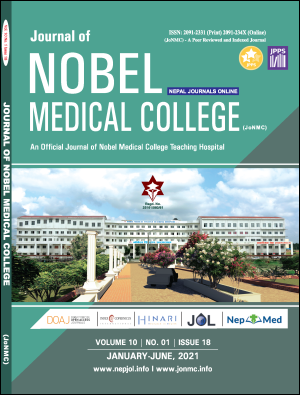Prevalence and Pattern of Birth Defects in a Tertiary Referral Center
DOI:
https://doi.org/10.3126/jonmc.v10i1.37929Keywords:
Anencephaly, Birth Defects, Consanguinity, Folic acidAbstract
Background: Congenital disorders (birth defects) are structural or functional abnormalities, which are present from birth, whether recognized at birth or later and constitute a major health problem worldwide. Congenital anomalies occur in 3 to 5 % of all pregnancies and 2 to 3 % of all births. The exact magnitude of birth defect related events is still unrevealed. Prevalence is high in Nepal but true magnitude is still unknown.
Materials and Methods: This is a prospective cross sectional study of all antenatal women who had an ultrasound revealing congenital anomalies as well who delivered with a fetal congenital malformation at department of Obstetrics and Gynecology, Nobel Medical College Teaching Hospital. Maternal variables like age, parity, period of gestation at detection, medical history, mode of delivery and complications were recorded. Fetal outcomes and details of anomalies were analyzed. Consanguinity and history of use of folic acid was also inquired.
Results: Our institutional prevalence of congenital anomalies was 1.25%. The mean age of the mother is 25.88 years. Anencephaly was seen in 5 live birth among the mothers of consanguineous marriage. The predominant system involved was central nervous system 37(37%) followed by Musculoskeletal system 13 (13%). Most of them 38/56 (68%) were pre diagnosed by antenatal ultrasound only in the third trimester. Majority of them didn’t give history of the use of folic acid. Vaginal delivery was the preferred choice of the termination of pregnancy.
Conclusion: Congenital anomaly rate was 1.25% and Central Nervous System was the predominant system involved with Anencephaly being common in consanguineous marriage.
Downloads
Downloads
Published
How to Cite
Issue
Section
License
JoNMC applies the Creative Commons Attribution (CC BY) license to works we publish. Under this license, authors retain ownership of the copyright for their content, but they allow anyone to download, reuse, reprint, modify, distribute and/or copy the content as long as the original authors and source are cited.




